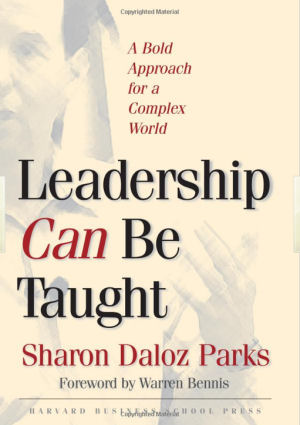
|
Posted March 6, 2011
Book: Leadership Can Be Taught Author: Sharon Daloz Parks Harvard Business School Press, Boston, Massachusetts, 2005. Pp. 287 An Excerpt from the Jacket:
In Leadership Can Be Taught, Sharon Daloz Parks invites readers to step into the classroom Harvard leadership virtuoso Ronald Heifetz and his colleagues to experience a dynamic type of leadership and a corresponding mode of learning called “case-in-point.” This unique approach utilizes students’ own experiences — and the classroom environment itself — as a “studio-laboratory” for working through the types of challenges people actually face in today’s workplace. In this setting, failures become active experiments not just in learning, but in living leadership. As Heifetz teaches it, leadership is not about wielding power and authority. It is about mobilizing people to make progress on the tough, adaptive challenges that make or break organizations, communities, and societies. It is about being able to both see the bigger picture and make decisions under fire — to “get out on the balcony so you can see the dance floor.” And contrary to popular notions about the importance of charism, leadership is not about personality, but presence — the capacity to foster collective action. An Excerpt from the Book: Unmasking the Power of Teachers In all educational experiences, people to one degree or another model themselves after the teacher, learning things that are not in the explicit content of what is being said or read, but that are implicit in the way the teacher goes about teaching. It is easy for teachers to underestimate how much is taught about “how to be” that goes unexamined. Students unconsciously drink in, for example, the way a teacher models the resolution of conflicts in class, solves problems, handles the introduction of deviant, innovative, troubling, or confusing points of view, and exercises authority. . . .The same awareness [of a teacher modeling behavior] was echoed in the reflection of a woman in mid-career: “I remember that once a man came into the class to fix the thermostat, and Heifetz just stared him out of the room. He said, “May I help you?” whereas I think most professors would have just ignored it. And the man said, “Well, I’m here to fix this thermostat.” Heifetz said, “You can do that later,” and the guy just left. That function of letting the group know that you’re going to protect the boundaries [so the class can do adaptive work] had never left me.” Table of Contents: 1. Leadership for a changing world: A call to adaptive work 2. How do we begin? Differing expectations 3. What is really going on here? Engaging people at the edge of learning 4. Learning from failure in public. The power of small group consultation 5. Listening to the music beneath the words. The practice of presence 6. What endures? The power of language, image, and metaphor 7. Courage and costs. Discovering how to teach the unteachable 8. The same approach — other teachers. The question of transferability 9. Toward a more adequate myth. The art of leadership 10. Leadership can be learned. Strengths and limitations of this approach |
|
